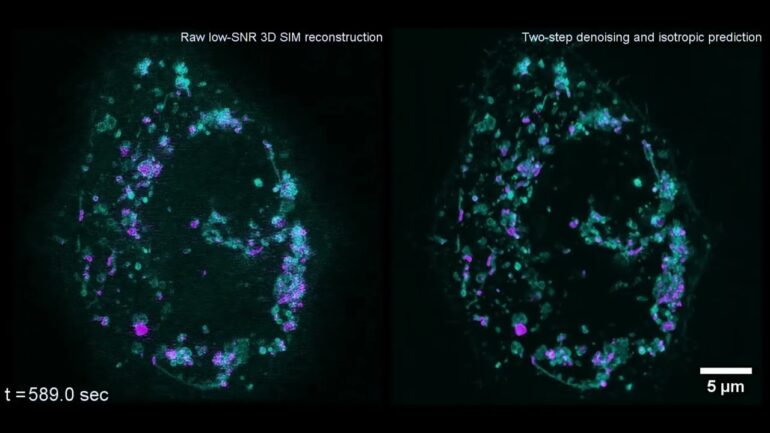New methods to improve super-resolution imaging techniques are giving biologists a clearer and more complete view of the inner workings of living cells.
A new paper in Nature Biotechnology from the Shroff Lab at Howard Hughes Medical Institute (HHMI)’s Janelia Research Campus details two practical ways to improve the axial (or z) resolution of 3D structured illumination microscopy, a technique to see inside living cells pioneered by former Janelia Group Leader Mats Gustafsson, who died in 2011.
In 3D-SIM and other fluorescence microscopy techniques, the axial resolution of the image is often blurred. This means researchers can clearly see details in two dimensions, on the x and y planes, but details in the third dimension, on the z plane, are fuzzy. Previous attempts to resolve this issue were difficult to implement.
A project led by Xuesong Li, a postdoc in the Shroff Lab, developed two ways to practically deal with the problem. In one method, a mirror is added to the microscope to create an additional beam of light, changing the interference pattern, and enabling finer, sharper resolution along the z axis.
The second method, which uses deep learning, blurs the sharp x and y axes to look like the blurry z axis and then trains a neural network to reverse these blurry images. The network then uses that information to un-blur the z axis.
Both methods provide a practical and effective way to improve axial resolution in 3D-SIM. This enables scientists to view the organelles inside cells sharply in all directions and potentially uncover new insights about the components inside cells.
The new methods can be used to improve other microscopes, and the team is working to apply the methods to thicker samples. Some of the same concepts may also be useful in imaging techniques they are developing for use by biologists working in Janelia’s new research area, 4D Cellular Physiology.
More information:
Xuesong Li et al, Three-dimensional structured illumination microscopy with enhanced axial resolution, Nature Biotechnology (2023). DOI: 10.1038/s41587-022-01651-1
Provided by
Howard Hughes Medical Institute
Citation:
New methods to improve super-resolution imaging techniques give a sharper view inside cells (2023, January 26)
